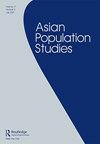Divorce trends in China across time and space: an update
IF 1.5
4区 社会学
Q2 DEMOGRAPHY
引用次数: 18
Abstract
ABSTRACT Despite much attention paid to the surging divorce rate in China, knowledge on divorce patterns and trends at the subnational level is still very limited. This study aims to systematically explore social and economic factors affecting divorce trends between 1990 and 2015 at the provincial level from a tempo–spatial perspective. Traditional fixed effects panel regression and fixed effects spatial autoregression are adopted. Divorce maps demonstrated great variations in the levels and trends of divorce across provinces, highlighting the spatial diversities obscured in the national divorce trend. It is further revealed that factors such as economic development, urbanisation, and employment have augmented their influence over time. Factors that reflect gender equality issues such as the gender gap in education, employment, and sex ratio at birth have different effects across the East, Central and West regions in China. These findings provide insights into the future prospects of divorce in China.跨越时空的中国离婚趋势:最新进展
尽管人们对中国不断飙升的离婚率关注甚多,但对地方离婚模式和趋势的了解仍然非常有限。本研究旨在从时空角度系统探讨1990 - 2015年省级离婚趋势的社会经济影响因素。采用传统的固定效应面板回归和固定效应空间自回归。离婚地图显示了各省离婚水平和趋势的巨大差异,突出了在全国离婚趋势中被掩盖的空间多样性。研究进一步揭示,经济发展、城市化和就业等因素的影响随着时间的推移而增强。反映性别平等问题的因素,如教育、就业和出生性别比方面的性别差距,在中国东部、中部和西部地区有不同的影响。这些发现为中国离婚的未来前景提供了见解。
本文章由计算机程序翻译,如有差异,请以英文原文为准。
求助全文
约1分钟内获得全文
求助全文
来源期刊

Asian Population Studies
DEMOGRAPHY-
CiteScore
3.30
自引率
14.30%
发文量
12
期刊介绍:
The first international population journal to focus exclusively on population issues in Asia, Asian Population Studies publishes original research on matters related to population in this large, complex and rapidly changing region, and welcomes substantive empirical analyses, theoretical works, applied research, and contributions to methodology.
 求助内容:
求助内容: 应助结果提醒方式:
应助结果提醒方式:


